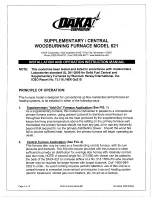
19
Vermont Castings Concord
30005102
Note:
Some chimneys need to be “primed,” or
warmed up, before they will draw sufficiently to sus-
tain a fire. To correct this situation, roll up a couple
pieces of newspaper, place them on top of the
kindling and toward the back of the stove, light them,
and close the doors. This should heat the chimney
enough to initiate strong draft.
Once the draft is established, open the front doors
and light the rest of the fuel bed at the bottom. Do
not light the main bed of fuel until the chimney be-
gins drawing.
Step 4. After the stove has been broken-in using Steps
1-3, continue to build the fire gradually. Add larger
wood with a diameter of 3-4” (75-100 mm).
Continue adding split logs of this size to the briskly-
burning fire until there is a glowing ember bed at
least 2” (50 mm) deep. A good ember bed is neces-
sary for proper functioning and may take up to an
hour to establish.
Step 5. Adjust the thermostatic air control for the de-
sired heat output.
refuel while the embers are Still hot
Reload the Concord while it is still hot and there are
plenty of glowing embers to re-kindle the fire. Include
some smaller pieces of wood in the new load of fuel
to help the stove return to its operating temperature
quickly. Wear stove gloves, and follow this procedure
when you reload your stove:
Step 1. Open the thermostat lever.
Step 2. Open the doors and check the ash level in the
ash pan. If necessary, dispose of the ashes and
replace the pan.
Step 3. Use a fireplace tool to break up the charcoal
and direct ash through the grate. Pull the charcoal
from the back to the front.
Step 4. Load wood — smaller, split pieces first. Close
the doors. Ideal performance will be achieved by
operating with the air control set in the maximum
(HIGH) positon for several minutes after refueling.
Reset the primary air control for the desired heat
output after the fire is re-established.
ash disposal
Remove ash before it reaches the top of the ash pan.
Check the level at least once a day, and before each re-
fueling. Using stove gloves, pull the ash pan out of the
stove by its handle. Remove the ash pan and properly
dispose of the ashes. Be sure to keep the pan level dur-
ing disposal.
Empty the ash pan regularly, typically every one to
three days. The frequency will vary depending on how
you operate your Concord; if you burn more wood at
higher heat output settings, ash will accumulate rapidly.
Dispose of ashes into a metal container with a tight-fit-
ting lid, kept outdoors. Put the closed container of ash
on a noncombustible floor or on the ground, well away
from all combustible materials, pending final disposal.
If the ash is disposed of by burial in soil or otherwise
locally dispersed, keep it in the closed container until all
cinders have thoroughly cooled. You can use wood ash
as a garden fertilizer.
cautioN: Never use your household or shop vac-
uum cleaner to remove ash from the stove; always
remove and dispose of the ash properly.
Smoke detectors
The use of smoke detectors throughout the home is
strongly advised, if not required by building codes or in-
surance regulations. It is a good idea to install a smoke
detector in the living areas and each bedroom.
You may not, however, wish to install a detector in the
immediate vicinity of the stove. Depending on the sensi-
tivity of the unit, the alarm can be set off while you are
tending the fire or emptying the ashes. If you install a
detector in the same room, locate it as far away from
the stove as possible.
cautioN: avoid slamming the stove door or
striking the glass panel. do not operate the
stove with the glass panel missing, damaged,
or broken. do not install substitute materi-
als. See maintenance section for replacement
instructions.










































